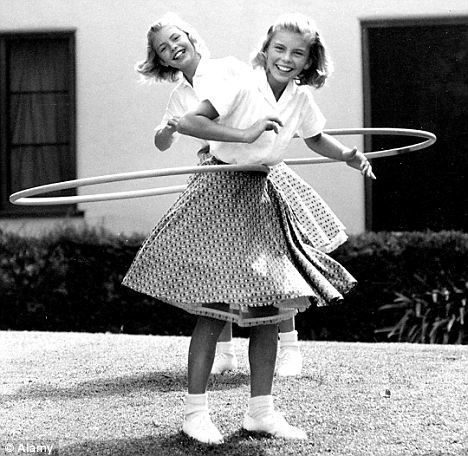-----------ooOoo-----------
Continuing a look at the events and people in Billy Joel’s We Didn’t Start the Fire.
Each two lines represent a year.
Little Rock, Pasternak, Mickey Mantle, Kerouac
Sputnik, Chou En-Lai, "Bridge on the River Kwai"
Lebanon, Charles de Gaulle, California baseball
Starkweather homicide, children of thalidomide
Buddy Holly, "Ben Hur", space monkey, Mafia
Hula hoops, Castro, Edsel is a no-go
U-2, Syngman Rhee, payola and Kennedy
Chubby Checker, "Psycho", Belgians in the Congo
1959: Hula Hoops
-----------ooOoo-----------
A hula hoop is a toy hoop that is twirled around the waist, limbs or neck. It can also be wheeled along the ground like a wheel with careful execution. They have been used by children and adults since at least 500 BC.
The hula hoop gained international popularity in the late 1950s, when a plastic version was successfully marketed by California's Wham-O toy company. Cane hoops had been popular children's toys to be rolled on the ground and kept balanced for as long as possible. In 1957, children in the Norwegian town of Steinkjer began a fad described in the English press as "rock-rings", with the description being "These are huge cane rings which little girls swing round their bodies by moving their hips and arms." An August 7 news item described the origin as children buying cane rings after seeing ring jugglers at a circus that visited Steinkjer and added "It wasn't long before most of the children in the town had caught the 'wiggle-rock' craze. Now it is all over Norway."
In the same summer, schoolgirls in Australia were using the hoops and news came to the United States with the first reference to the toy as a "Hula hoop", described as "all the rage among the female small fry of Australia. This is old fashioned hoops with a difference. You don't roll them, you put them around your middle and by swinging the hips in a circular motion to keep the hoop revolving— hence the name.".
Girl twirling a hula hoop 1958
According to "The Playmakers: Amazing Origins of Timeless Toys" by Tim Walsh, the bamboo hoop's path to plastic started in Australia when a Sydney teacher taught school students how to sway bamboo hoops in sports classes. Australia's Coles department stores then started selling bamboo hoops and demand soon outstripped supply. Coles then asked legendary toy man Alex Tolmer (also known as Alec), who founded toy company Toltoys, to help mass produce hoops. In 1957, Tolmer used Polyethylene which was stronger and less brittle than earlier plastics. The new lightweight plastic hoops sold in a variety of colours for less than $2. Toltoys sold 400,000 plastic hoops in Australia in 1957 alone. According to Tolmer's Melbourne-based son, David Tolmer, Toltoys already had a good working relationship with Wham-O in the United States and when Wham-O told Toltoys the hoop was too generic to warrant a royalty, Alex Tolmer instead asked the US company to sponsor one bed in an Australian children's hospital. By 1958, Wham-O plastic hoops were being used in California and then the craze for hooping swept the United States and beyond.
Richard Knerr and Arthur "Spud" Melin of Wham-O updated the Toltoys design and manufactured 110 cm (42 in) diameter hoops from Marlex plastic. The earliest known advertisement was seen for the "Hula-Hoop by Wham-O" was seen on June 16, 1958 for "The Broadway" chain of department stores in Los Angeles, for sale for $1.98 (equivalent to $20 more than 60 years later). With giveaways, national marketing and retailing, a fad began in July 1958: twenty-five million plastic hoops were sold in less than four months, and sales reached more than 100 million units in two years. Carlon Products Corporation was one of the first manufacturers of the hula hoop. During the 1950s, Carlon was producing more than 50,000 hula hoops per day. Saddled with a glut of unwanted Hula Hoops, Wham-O stopped manufacturing the toy until 1965, when Knerr and Melin came up with a new twist: They inserted ball bearings in the cylinder to make a "shoosh" sound. The hoop was inducted into the National Toy Hall of Fame at The Strong in Rochester, New York, in 1999.
The hula hoop craze swept the world, dying out in the 1980s except in China and Russia, where hula hooping and hoop manipulation were adopted by traditional circuses and rhythmic gymnasts. In the mid to late 1990s there was a re-emergence of hula hooping, generally referred to as either "hoopdance" or simply "hooping" to distinguish it from the children's playform. The jam band The String Cheese Incident is widely credited with fostering a renewed interest in hooping. Band members started throwing larger adult-sized hoops into their audiences in the mid-1990s, encouraging their fans to hoop and dance, spreading the word and the fun. It wasn't until 2003 with the launch of a former website, Hooping.org, that these small bands of hoopers began to find each other online and a real community and movement began to grow. Bay Area Hoopers began in San Francisco at that time holding regular "hoop jams" with music to hoop to and the hooping group began being replicated in cities around the world.
-----------ooOoo-----------
The final season of M*A*S*H contains an episode titled "Who Knew?", in which Sergeant Klinger observes children playing with barrel rings, and fashions a hula hoop-like toy made of metal tubing. He then tries to get Major Winchester to fund their production, but fails.
-----------ooOoo-----------
Marawa (née Ibrahim, formerly Wamp), stage name Marawa the Amazing, is an Australian-born performer, athlete, and author. She has held 12 different Guinness World Records, but is best known for holding the record for the most simultaneous twirling hula hoops, having spun 200.
-----------ooOoo-----------
Gallery:
fffffff
7 Art Linkletter with kids
8
Jane Russell






No comments:
Post a Comment
Note: Only a member of this blog may post a comment.